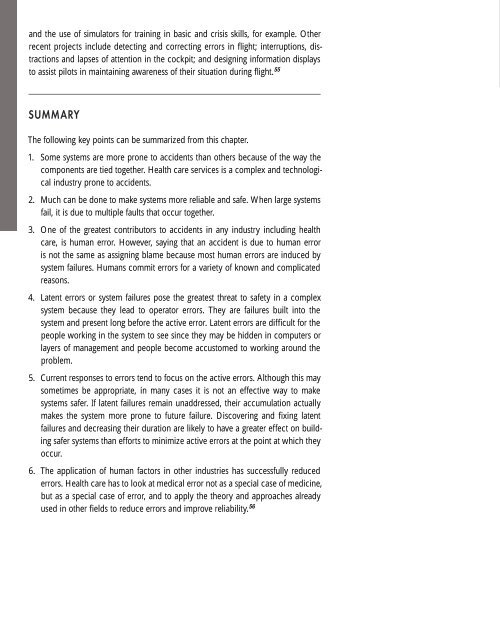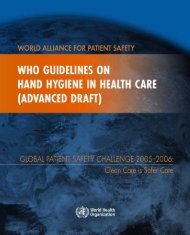and the use of simulators for training in basic and crisis skills, for example. Other recent projects include detecting and correcting errors in flight; interruptions, distractions and lapses of attention in the cockpit; and designing information displays to assist pilots in maintaining awareness of their situation during flight. 55 SUMMARY The following key points can be summarized from this chapter. 1. Some systems are more prone to accidents than others because of the way the components are tied together. Health care services is a complex and technological industry prone to accidents. 2. Much can be done to make systems more reliable and safe. When large systems fail, it is due to multiple faults that occur together. 3. One of the greatest contributors to accidents in any industry including health care, is human error. However, saying that an accident is due to human error is not the same as assigning blame because most human errors are induced by system failures. Humans commit errors for a variety of known and complicated reasons. 4. Latent errors or system failures pose the greatest threat to safety in a complex system because they lead to operator errors. They are failures built into the system and present long before the active error. Latent errors are difficult for the people working in the system to see since they may be hidden in computers or layers of management and people become accustomed to working around the problem. 5. Current responses to errors tend to focus on the active errors. Although this may sometimes be appropriate, in many cases it is not an effective way to make systems safer. If latent failures remain unaddressed, their accumulation actually makes the system more prone to future failure. Discovering and fixing latent failures and decreasing their duration are likely to have a greater effect on building safer systems than efforts to minimize active errors at the point at which they occur. 6. The application of human factors in other industries has successfully reduced errors. Health care has to look at medical error not as a special case of medicine, but as a special case of error, and to apply the theory and approaches already used in other fields to reduce errors and improve reliability. 56
REFERENCES 1. 2. 3. 4. 5. 6. 7. 8. 9. Senders, John, “Medical Devices, Medical Errors and Medical Accidents,” in Human Error in Medicine, ed., Marilyn Sue Bogner, Hillsdale, NJ: Lawrence Erlbaum Associates, 1994. Cook, Richard; Woods, David; Miller, Charlotte, A Tale of Two Stories: Contrasting Views of Patient Safety, Chicago: National Patient Safety Foundation, 1998. Cook, Richard and Woods, David, “Operating at the Sharp End: The Complexity of Human Error,” in Human Error in Medicine, ed., Marilyn Sue Bogner, Hillsdale, NJ: Lawrence Erlbaum Associates, 1994. Perrow, Charles, Normal Accidents, New York: Basic Books, 1984. Reason, James, Human Error, Cambridge: Cambridge University Press, 1990. Perrow, 1984; Cook and Woods, 1994. Gaba, David M.; Maxwell, Margaret; DeAnda, Abe, Jr.. Anesthetic Mishaps: Breaking the Chain of Accident Evolution. Anesthesiology. 66(5):670–676, 1987. Perrow, 1984. Van Cott, Harold, “Human Errors: Their Causes and Reductions,” in Human Error in Medicine, ed., Marilyn Sue Bogner, Hillsdale, NJ: Lawrence Erlbaum Associates, 1994. Also, Roberts, Karlene, “Organizational Change and A Culture of Safety,” in Proceedings of Enhancing Patient Safety and Reducing Errors in Health Care, Chicago: National Patient Safety Foundation at the AMA, 1999. 10. Reason, 1990. See also Cook, Woods and Miller, 1998. 11. Norman, Donald, Things That Make Us Smart, Defending Human Attributes in the Age of Machines, Menlo Park, CA: Addison-Wesley Publishing Co., 1993. 12. Cooper, Jeffrey B.; Newbower, Ronald; Long, Charlene, et al. Pr<strong>event</strong>able Anesthesia Mishaps: A Study of Human Factors. Anesthesiology. 49(6):399–406, 1978. 13. Cooper, Jeffrey B. and Gaba, David M. A Strategy for Pr<strong>event</strong>ing Anesthesia Accidents. International Anesthesia Clinics. 27(3):148–152, 1989 14. Reason, 1990. 15. Chassin, Mark R.; Galvin, Robert W., and the National Roundtable on Health Care Quality. The Urgent Need to Improve Health Care Quality, JAMA. 280(11):1000–1005, 1998. 16. Reason, 1990. 17. Cook, Woods and Miller, 1998. 18. Reason, 1990. 19. Vaughan, Diane, The Challenger Launch Decision, Chicago: The University of Chicago Press, 1996. 20. Reason, 1990. 21. Reason, 1990. 22. Roberts, Karlene, 1999. See also: Gaba, David, “Risk, Regulation, Litigation and Organizational Issues in Safety in High-Hazard Industries,” position paper for Work- shop on Organizational Analysis in High Hazard Production Systems: An Academy/ Industry Dialogue,” MIT Endicott House, April 15–18, 1997, NSF Grant No. 9510883-SBR. 23. Sagan, Scott D., The Limits of Safety, Princeton, NJ: Princeton University Press, 1993. 24. Sagan, Scott D., 1993 and Robert, Karlene, 1999. 25. Reason, James, “Forward,” in Human Error in Medicine, ed., Marilyn Sue Bogner, Hillsdale, NJ: Lawrence Erlbaum Associates, 1994. 26. “Agenda for Research and Development in Patient Safety,” National Patient Safety Foundation at the AMA, http://www.ama-assn.org/med-sci/npsf/research/research.htm. May 24, 1999. 27. Dye, Kevin M.C.; Post, Diana; Vogt, Eleanor, “Developing a Consensus on the Accountability and Responsibility for the Safe Use of Pharmaceuticals,” Preliminary White Paper prepared for the National Patient Safety Foundation, June 1, 1999. 28. Brewer, Timothy; Colditz, Graham A. Postmarketing Surveillance and <strong>Adverse</strong> Drug Reactions, Current Perspectives and Future Needs. JAMA. 281(9):824–829, 1999. 29. VHA’s Patient Safety Improvement Initiative, presentation to the National Health Policy Forum by Kenneth W. Kizer, Under Secretary for Health, Department of Veterans Affairs, May 14, 1999, Washington, D.C. 30. Leape, Lucian L. Error in Medicine. JAMA. 272(23):1851–1857, 1994. 31. Perrow, 1984.
















